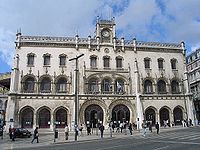
Rossio Train Station
Encyclopedia


Train station
A train station, also called a railroad station or railway station and often shortened to just station,"Station" is commonly understood to mean "train station" unless otherwise qualified. This is evident from dictionary entries e.g...
in Lisbon
Lisbon
Lisbon is the capital city and largest city of Portugal with a population of 545,245 within its administrative limits on a land area of . The urban area of Lisbon extends beyond the administrative city limits with a population of 3 million on an area of , making it the 9th most populous urban...
, Portugal
Portugal
Portugal , officially the Portuguese Republic is a country situated in southwestern Europe on the Iberian Peninsula. Portugal is the westernmost country of Europe, and is bordered by the Atlantic Ocean to the West and South and by Spain to the North and East. The Atlantic archipelagos of the...
, located in the Rossio square
Rossio
The Rossio is the popular name of the Pedro IV Square in the city of Lisbon, in Portugal. It is located in the Pombaline Downtown of Lisbon and has been one of its main squares since the Middle Ages...
. The station was formerly known as Estação Central (Central Station) and that designation still appears in its façade.
The Station was commissioned by the Portuguese Royal Railway Company and was designed between 1886 and 1887 by Portuguese architect José Luís Monteiro. It was built in one the most important squares of Lisbon, the Rossio
Rossio
The Rossio is the popular name of the Pedro IV Square in the city of Lisbon, in Portugal. It is located in the Pombaline Downtown of Lisbon and has been one of its main squares since the Middle Ages...
, and connected the city to the region of Sintra
Sintra
Sintra is a town within the municipality of Sintra in the Grande Lisboa subregion of Portugal. Owing to its 19th century Romantic architecture and landscapes, becoming a major tourist centre, visited by many day-trippers who travel from the urbanized suburbs and capital of Lisbon.In addition to...
.
Trains gain access to the station, which is in the central urban area of Lisbon, through a tunnel which is more than 2600m long. This tunnel was excavated under the city and is considered one of the most important works of engineering of Portugal dating from the 19th century. It was completed in 1890, and soon after Lisbon's Circle Line with a connection to the North Line also opened. The station became Lisbon's main passenger terminus until 1957, from that date only a few long distance trains terminated at Rossio, mainly Oeste Line services, until the early 1990s.
The station was closed to rail services from 22 October 2004 until 12 February 2008 due to tunnel renewal work.
The beautiful Neo-Manueline
Neo-Manueline
Neo-Manueline was a revival architecture and decorative arts style developed in Portugal between the middle of the 19th century and the beginning of the 20th century...
façade dominates the northwest side of the square and is a Romantic
Romanticism
Romanticism was an artistic, literary and intellectual movement that originated in the second half of the 18th century in Europe, and gained strength in reaction to the Industrial Revolution...
recreation of the exuberant Manueline
Manueline
The Manueline, or Portuguese late Gothic, is the sumptuous, composite Portuguese style of architectural ornamentation of the first decades of the 16th century, incorporating maritime elements and representations of the discoveries brought from the voyages of Vasco da Gama and Pedro Álvares Cabral...
style, typical of early 16th century Portugal. Its most interesting features are the two intertwined horseshoe portals at the entrance, the clock in a small turret and the abundant sculptural decoration. Inside, the platforms are connected by ramps to the façade level and are covered by a cast-iron structure executed by a Belgium
Belgium
Belgium , officially the Kingdom of Belgium, is a federal state in Western Europe. It is a founding member of the European Union and hosts the EU's headquarters, and those of several other major international organisations such as NATO.Belgium is also a member of, or affiliated to, many...
firm. The station is an important example of Romantic
Romanticism
Romanticism was an artistic, literary and intellectual movement that originated in the second half of the 18th century in Europe, and gained strength in reaction to the Industrial Revolution...
(façade) and Cast-iron
Cast-iron architecture
Cast-iron architecture is a form of architecture where cast iron plays a central role. It was a prominent style in the Industrial Revolution era when cast iron was relatively cheap and modern steel had not yet been developed.-Structural use:...
(platform cover) architecture in Portugal.
Beside the station there is a Beaux-Arts style building, the Hotel Avenida, opened in 1892 and also designed by José Luís Monteiro.
See also
- RossioRossioThe Rossio is the popular name of the Pedro IV Square in the city of Lisbon, in Portugal. It is located in the Pombaline Downtown of Lisbon and has been one of its main squares since the Middle Ages...
- Neo-ManuelineNeo-ManuelineNeo-Manueline was a revival architecture and decorative arts style developed in Portugal between the middle of the 19th century and the beginning of the 20th century...

